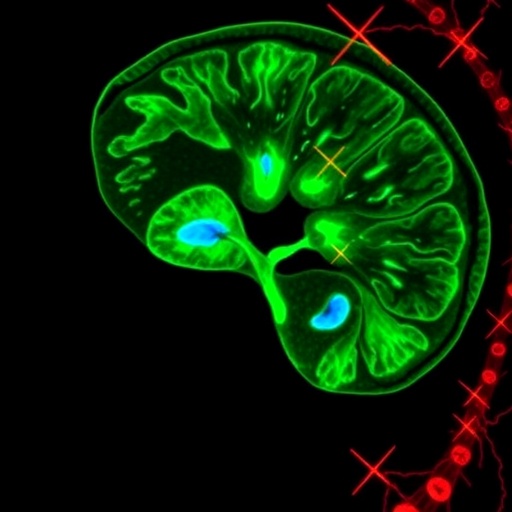In a groundbreaking review published in the esteemed journal “Pediatric Radiology,” a team of researchers led by Dasic et al. delves into the imaging findings associated with pediatric non-Hodgkin lymphoma (NHL). This pictorial review not only highlights the critical role of imaging in the diagnosis and management of this condition but also emphasizes the peculiar characteristics that differentiate pediatric presentations from adult counterparts. The findings provide essential insights for radiologists and pediatric oncologists, offering a comprehensive resource for professionals dealing with this complex illness.
Pediatric non-Hodgkin lymphoma encompasses a diverse group of malignancies distinct from the adult forms of the disease. Early recognition and accurate diagnosis of NHL in children are crucial, as these factors significantly influence treatment approaches and prognostic outcomes. Radiologic assessment plays a pivotal role in this context, with various imaging modalities such as ultrasound, computed tomography (CT), and magnetic resonance imaging (MRI) being utilized to identify tumors and other related manifestations. Moreover, this review meticulously presents the visual aspects of these modalities, serving as a guide for healthcare professionals.
One notable aspect of pediatric NHL is its varied presentations, which can complicate its diagnosis. Unlike adults, where organ-specific symptoms may dominate, children may exhibit nonspecific signs. Symptoms such as fatigue, fever, and generalized lymphadenopathy often predominate. The review discusses the importance of recognizing these signs early on, suggesting that timely imaging studies can lead to quicker diagnosis and intervention, significantly enhancing patient outcomes.
The authors further elucidate the imaging characteristics of different subtypes of pediatric NHL, breaking down the typical appearances seen in various imaging modalities. For instance, CT scans often highlight enlarged lymph nodes in conventional areas, such as the cervical region, abdomen, and mediastinum, which are crucial for staging. MRI is especially useful in the assessment of central nervous system involvement, which can occur more frequently in pediatric cases, necessitating a comprehensive understanding of these features by radiologists.
In terms of ultrasound, the review indicates that this modality can provide rapid, bedside solutions for initial evaluations. The non-invasive nature and accessibility of ultrasound make it an excellent first-line tool for assessing lymphadenopathy in children. Dasic et al. highlight how this can be particularly beneficial in a pediatric setting, where concerns about radiation exposure are paramount. The review further details the sonographic characteristics found in lymphomas, allowing clinicians to differentiate them from benign lymphadenopathy and other potential diagnoses.
An essential aspect addressed in the review is the role of advanced imaging techniques, such as PET-CT, in the staging of pediatric NHL. Positron emission tomography combined with computed tomography provides unique metabolic information that can aid in assessing disease activity and treatment response. The incorporation of metabolic imaging is a significant advancement, giving clinicians a clearer understanding of tumor dynamics and their implications for prognosis and therapy.
Furthermore, Dasic et al. provide a critical overview of the complications associated with pediatric non-Hodgkin lymphoma. This includes the risk of infectious complications due to immune suppression from both the disease and its treatments. The imaging characteristics of such complications, whether they arise from neutropenic fever or cytotoxic therapy, are essential considerations that the authors meticulously outline, underscoring the need for vigilance in monitoring these at-risk patients.
An additional unique feature of this pictorial review is its focus on the differential diagnosis. The authors guide the readers through a range of conditions that may mimic or present similarly to pediatric NHL. This is particularly relevant, as misdiagnosis can lead to delays in treatment and unfavorable outcomes. By discussing entities such as infections, autoimmune disorders, and other malignancies, the review underscores the importance of a careful and methodical approach to pediatric imaging.
Another compelling angle presented is the imaging follow-up protocols for children diagnosed with NHL. Regular imaging is crucial to monitor response to treatment and detect any recurrence. The authors provide evidence-based recommendations for the frequency and type of imaging necessary at various stages of follow-up. Such insights are invaluable, as they can help streamline care pathways and reassure both patients and parents in what can be an emotionally challenging time.
Ultimately, the advent of this pictorial review marks a significant milestone in the ongoing effort to enhance the diagnostic capabilities of pediatricians and radiologists alike. By combining clinical insights with a rich array of imaging visuals, Dasic et al. equip medical professionals with the tools necessary to recognize and manage pediatric non-Hodgkin lymphoma effectively. This is not just an academic resource; it represents a lifeline for countless young patients navigating the complexities of cancer treatment.
In conclusion, the research not only highlights the significance of imaging in pediatric non-Hodgkin lymphoma but also urges further exploration into this vital area of pediatric oncology. With ongoing advancements in imaging technologies and methodologies, the potential to improve diagnostic accuracy and patient outcomes is immense. As the field continues to evolve, such comprehensive reviews will remain essential, guiding future research and clinical practices in the fight against childhood cancer.
Subject of Research: Pediatric Non-Hodgkin Lymphoma Imaging
Article Title: Imaging findings in pediatric non-Hodgkin lymphoma: a pictorial review
Article References:
Dasic, I., Littooij, A., Tolboom, N. et al. Imaging findings in paediatric non-Hodgkin lymphoma: a pictorial review. Pediatr Radiol (2025). https://doi.org/10.1007/s00247-025-06396-y
Image Credits: AI Generated
DOI:
Keywords: Pediatric non-Hodgkin lymphoma, imaging findings, pediatric radiology, CT, MRI, ultrasound, PET-CT, differential diagnosis, oncology, treatment response.




